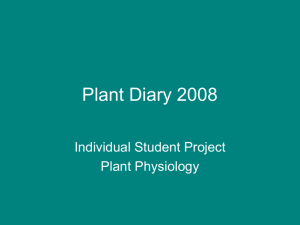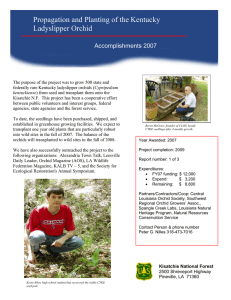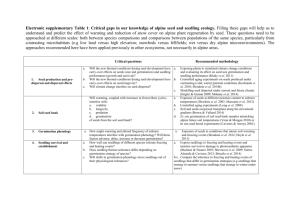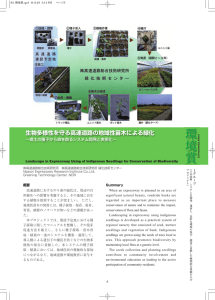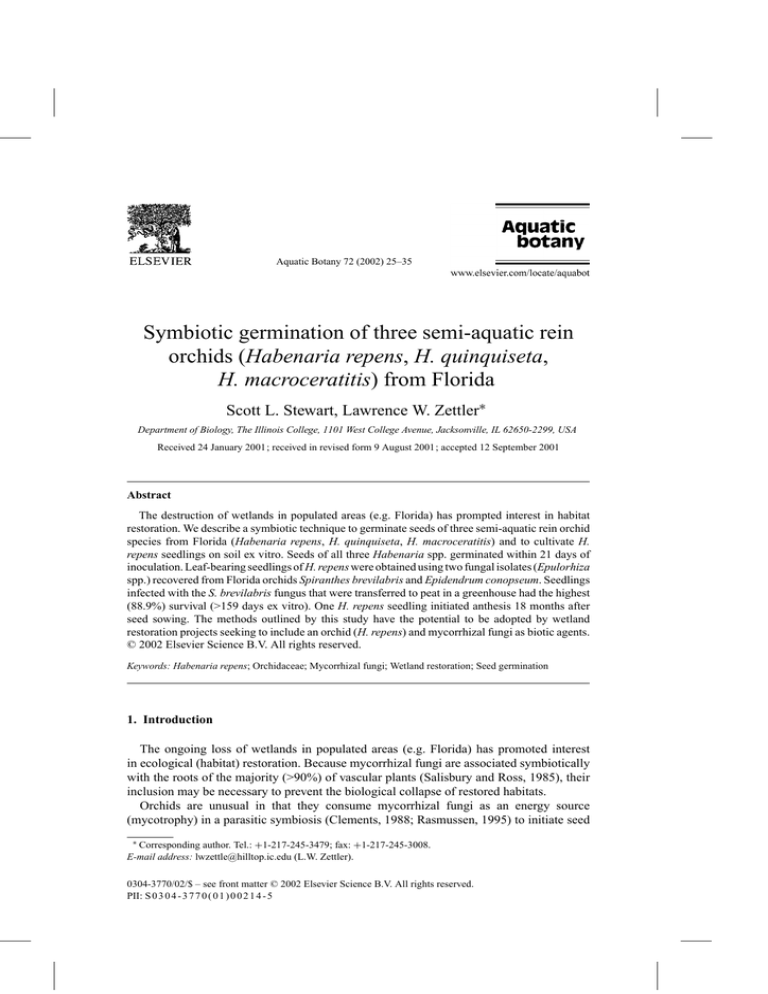
Aquatic Botany 72 (2002) 25–35
Symbiotic germination of three semi-aquatic rein
orchids (Habenaria repens, H. quinquiseta,
H. macroceratitis) from Florida
Scott L. Stewart, Lawrence W. Zettler∗
Department of Biology, The Illinois College, 1101 West College Avenue, Jacksonville, IL 62650-2299, USA
Received 24 January 2001; received in revised form 9 August 2001; accepted 12 September 2001
Abstract
The destruction of wetlands in populated areas (e.g. Florida) has prompted interest in habitat
restoration. We describe a symbiotic technique to germinate seeds of three semi-aquatic rein orchid
species from Florida (Habenaria repens, H. quinquiseta, H. macroceratitis) and to cultivate H.
repens seedlings on soil ex vitro. Seeds of all three Habenaria spp. germinated within 21 days of
inoculation. Leaf-bearing seedlings of H. repens were obtained using two fungal isolates (Epulorhiza
spp.) recovered from Florida orchids Spiranthes brevilabris and Epidendrum conopseum. Seedlings
infected with the S. brevilabris fungus that were transferred to peat in a greenhouse had the highest
(88.9%) survival (>159 days ex vitro). One H. repens seedling initiated anthesis 18 months after
seed sowing. The methods outlined by this study have the potential to be adopted by wetland
restoration projects seeking to include an orchid (H. repens) and mycorrhizal fungi as biotic agents.
© 2002 Elsevier Science B.V. All rights reserved.
Keywords: Habenaria repens; Orchidaceae; Mycorrhizal fungi; Wetland restoration; Seed germination
1. Introduction
The ongoing loss of wetlands in populated areas (e.g. Florida) has promoted interest
in ecological (habitat) restoration. Because mycorrhizal fungi are associated symbiotically
with the roots of the majority (>90%) of vascular plants (Salisbury and Ross, 1985), their
inclusion may be necessary to prevent the biological collapse of restored habitats.
Orchids are unusual in that they consume mycorrhizal fungi as an energy source
(mycotrophy) in a parasitic symbiosis (Clements, 1988; Rasmussen, 1995) to initiate seed
∗ Corresponding author. Tel.: +1-217-245-3479; fax: +1-217-245-3008.
E-mail address: lwzettle@hilltop.ic.edu (L.W. Zettler).
0304-3770/02/$ – see front matter © 2002 Elsevier Science B.V. All rights reserved.
PII: S 0 3 0 4 - 3 7 7 0 ( 0 1 ) 0 0 2 1 4 - 5
26
S.L. Stewart, L.W. Zettler / Aquatic Botany 72 (2002) 25–35
germination and seedling development (Arditti, 1966). Consequently, the establishment of
orchids in restored habitats requires the presence of mycorrhizal fungi to recruit seedlings
(Zettler, 1997a). One possible way to promote this process is by symbiotic seed germination (Clements et al., 1986; Dixon, 1987). Briefly, orchid seedlings cultured in vitro with
mycorrhizal fungi could be introduced ex vitro into suitable habitats, with seedlings serving as a source of inoculum. Unfortunately, few orchids native to North America have been
successfully propagated in this manner (Zettler, 1996), and little is known about the identity
of their mycorrhizal symbionts.
To date, symbiotic techniques have yet to be applied to the rein orchids of the Western
Hemisphere (genus Habenaria). However, members of Platanthera (recently segregated
from Habenaria) have been propagated from seed using fungi (Zettler, 1996). This study
examines the plausibility of propagating species of Habenaria using methods applied to
Platanthera.
In this paper, we describe seed germination techniques for three semi-aquatic Habenaria
species (Habenaria quinquiseta, H. macroceratitis, H. repens) in vitro using orchid mycorrhizal fungi from Florida, and provide a method to establish H. repens seedlings in soil
ex vitro. This paper demonstrates that semi-aquatic orchids can be propagated successfully
for potential use in wetland restoration projects.
2. Materials and methods
2.1. Fungal isolation and characterization
Four mycorrhizal fungus isolates, recovered from the root-like organs of orchids
native to Florida, were chosen for in vitro seed germination of H. repens Nuttall, H. quinquiseta (Michaux) Eaton and H. macroceratitis (Willd.) Luer (Table 1). Two of the isolates
(Econ-242, Sbrev-266) were chosen because of their effectiveness at germinating seeds
of other Florida orchids (Epidendrum conopseum R. Brown, Encyclia tampensis (Lindl.)
Small, and S. brevilabris Lindley) (Zettler et al., 1998, 1999; Minso et al., 2001). Two isolates (Hmac-292, Hque-291) were chosen because they originated from H. macroceratitis
and H. quinquiseta, respectively. Three isolates, Econ-242, Sbrev-266, and Hmac-292, were
deposited into the University of Alberta (Canada) Microfungus Collection and Herbarium
Table 1
Original sources of mycorrhizal fungi used in the inoculation of Habenaria seeds
Isolate
Host orchid
Host/collection information
Econ-242 (UAMH 9203)
E. conpseum
Sbrev-266 (UAMH 9824)
S. brevilabris
Hque-291
H. quinqueseta
Hmac-292 (UAMH 9826)
H. macroceratitis
Common epiphyte; collected 7 June 1995 from SW
Alachua Co., FL
Endangered terrestrial; collected 10 May 1999 from
a roadside population in NW Marion Co., FL
Terrestrial; collected 9 October 1999 from Cross
Florida Greenway, Marion Co., FL
Terrestrial; collected 9 October 1999 from the
Indian Ledges site, Sumter Co., FL
S.L. Stewart, L.W. Zettler / Aquatic Botany 72 (2002) 25–35
27
as UAMH 9203, 9824, and 9826, respectively. All fungi were isolated following procedures described by Currah et al. (1987) and Zettler (1997b). Leaf-bearing specimens with
intact root systems were collected, placed in plastic bags, stored in darkness at ca. 10 ◦ C
and transported to the laboratory (<1 week). Roots were then detached, rinsed with tap
water to remove debris, and surface sterilized 1 min in a solution of absolute EtOH: 5.25%
NaOCl (CloroxTM ): deionized (DI) water (1:1:1, v/v/v). Clumps of cortical cells containing pelotons (Currah et al., 1987) were removed from root segments, plated on modified
Melin–Norkran’s agar (MMN; Marx, 1969), and incubated at 22 ◦ C for 1 week. Hyphal
tips were excised from actively-growing pelotons and subcultured onto potato dextrose agar
(PDA, Difco). Fungal isolates with cultural characteristics resembling endophytes previously described in literature (e.g. Currah et al., 1987; Richardson et al., 1993; Zettler, 1997b)
were assigned reference numbers and stored at 6 ◦ C on modified oats medium (MOM):
2.5 g rolled oats, 7.0 g agar, 1 l DI water (Dixon, 1987) until used in seed germination
experiments. Fungal characterization and identification followed the methods and descriptions outlined in Currah et al. (1987, 1990), Zelmer and Currah (1995) and Zelmer et al.
(1996).
2.2. Seed collection, sowing and incubation in vitro
Seeds were obtained from ripening (yellow) capsules prior to dehiscence on 9–10 October 1999. H. quinquiseta, H. macroceratitis, and H. repens seeds originated from the
Cross Florida Greenway (Marion Co.), Indian Ledges (Sumter Co.), and Avon Park (Highlands Co.) sites, respectively. Immediately after collection, capsules were dried over CaSO4
(DrieriteTM ) desiccant for 1 week at 10–22 ◦ C, followed by storage at −7 ◦ C in darkness for
108 days. Seeds were sown according to the procedure described by Dixon (1987). Seeds
were removed from cold storage, surface sterilized (absolute EtOH: 5.25% NaOCl: DI water
(1:1:1, v/v/v)) for 1 min, and placed over the surface of a 1 cm × 4 cm filter paper (Whatman
No. 4) strip within a Petri plate containing 20 ml MOM. The agar pH was adjusted to 6.0
prior to autoclaving (121 ◦ C for 20 min) and changed little (+0.1) after autoclaving. This
pH value was chosen to parallel the presumed soil pH values of the orchid habitats. Between
50 and 200 seeds were sown per plate using a wire inoculation loop. Each plate was inoculated with a 1 cm3 block of fungal inoculum (one fungal isolate per plate, twelve replicate
plates per treatment) and plates without fungal inoculum served as controls (three replicate plates). Petri plates were sealed with Parafilm “M”® (Am. National Can, Greenwich,
CT), wrapped in aluminum foil to exclude light, and incubated in darkness (L:D, 0 h:24 h)
at 24 ± 2 ◦ C for 69 days, followed by a 12 h photoperiod (L:D, 12 h:12 h) at 24 + 2 ◦ C
lasting 13 days. Illumination, provided by four Verilux full spectrum F40T12VLX bulbs,
was measured to be 3930 lux at the plate surface. Plates were examined periodically (e.g.
weekly and monthly) during dark incubation for germination and contamination, exposing
the seeds to brief (<30 min) periods of illumination. Contaminated plates were discarded
leading to unequal subsample sizes. After inspection, plates were returned to experimental conditions. Seed viability, germination and seedling development were assessed using a
dissection microscope. Developmental growth stages were scored on a scale of 0–5 (Fig. 1).
Seed germination (stage 1 = initiation of rhizoid(s) by embryo) percentages were based on
viable seeds (i.e. those containing distinct, rounded and hyaline embryos).
28
S.L. Stewart, L.W. Zettler / Aquatic Botany 72 (2002) 25–35
Fig. 1. Seed germination and seedling developmental growth stages of Habenaria. Stage 0 = no germination. (1)
Production of rhizoid(s) by embryo as denoted by the arrow (=germination); (2) rupture of the testa by enlarging
embryo; (3) appearance of the shoot (=protomeristem) as denoted by the arrow; (4) emergence of leaf from shoot
region as denoted by arrow; (5) elongation of leaf. Scale bar = 1 mm.
2.3. Seedling establishment on soil ex vitro
Following artificial illumination, 72 leaf-bearing seedlings were randomly selected and
transferred to soil in a greenhouse ex vitro, 82 days after sowing. Half (36) of the seedlings
were placed on Miracle–Gro® Potting Mix (Miracle–Gro Lawn Products, Inc., Port
Washington, NY), and the other half on Schultz® Canadian Sphagnum Peat Moss (Schultz
S.L. Stewart, L.W. Zettler / Aquatic Botany 72 (2002) 25–35
29
Company, St. Louis, MO) following the procedure given by Zettler and McInnis (1992). Approximately, 15–20 g of soil was moistened with DI water and added to a 44 mm × 12.5 mm
aluminum dish (Fisher Scientific, Cat. #08-732-5A) that contained holes punctured by
means of a dissection needle. Each dish was placed in a covered, raised glass Petri plate
(one dish per plate) flooded with 10 ml DI water. Plates containing soil dishes were autoclaved and seedlings were then transferred from agar to soil (three seedlings per aluminum
dish) using sterile forceps. The glass lid was secured with Parafilm to maintain a high (ca.
100%) RH within the dish and to reduce exposure of the seedlings to airborne contaminants. Seedlings in glass dishes were artificially illuminated under a 12 h photoperiod at
24 ± 2 ◦ C for 25 days. After this time, aluminum dishes with seedlings were removed
from sterile conditions and placed on shallow, water-filled trays in a greenhouse (20–40 ◦ C,
40–70% RH) for 51 days under natural illumination. Tap water was added daily to each
tray so that the seedlings had access to a continuous supply of water. Subsequent growth
under these conditions made it necessary to transplant the seedlings to new (sterile) soil
in large (9 cm tall) plastic pots. Seedlings remained in pots (>41 days) until the study was
terminated.
To determine if a mycorrhizal symbiosis was established in vitro and persisted ex vitro,
some H. repens seedlings were examined for the presence of pelotons. Whole seedlings
(>stage 2) cultured in vitro, and root-like organs of seedlings cultured ex vitro, were removed
from experimental conditions, stained with trypan blue (Phillips and Hayman, 1970), and
examined by light microscopy. The remaining seedlings were retained for further study.
The propensity of plants to survive ex vitro (>159 days) was analyzed with a loglinear
model using SPSS 10.0 for Windows (SPSS, 1999). To increase the power for this analysis,
surviving seedlings were pooled among replicates within each fungus treatment (Econ-242
or Sbrev-266) and potting medium (peat or potting soil).
3. Results
3.1. Mycorrhizal fungi
Three fungal isolates recovered from pelotons in mature root-like organs of E. conopseum
(Econ-242), S. brevelabris (Sbrev-266), and H. macroceratitis (Hmac-292) were identified
as members of the anamorphic genus Epulorhiza Moore. These isolates closely resembled E.
repens (Bernard) Moore in having comparable growth rates and ovoid or spherical monilioid
cells. The fourth fungal isolate (Hque-291), recovered from H. quinquiseta, was identified
as a member of the anamorphic genus Ceratorhiza Moore. The presence of concentric
zonation and the lack of a pronounced isthmus between monilioid cells in the isolate are
characteristic features of C. goodyerae-repentis Constantin and Dufour.
3.2. Seed germination and development in vitro
Seeds of all three Habenaria species were monoembryonic. All inoculated seeds germinated within 21 days of sowing. Many of the stage 1 seedlings, particularly for H. macro-
30
S.L. Stewart, L.W. Zettler / Aquatic Botany 72 (2002) 25–35
Table 2
Seed germination and development of H. quinqueseta (Hque), H. repens (Hrep) and H. macroceratitis (Hmac) 68
days after sowing and incubation in darkness at 24 ◦ Ca
Seed
Fungus
nb
#Seeds
Stage
0
1
2
3
4
Hque
Hque-291
Sbrev-266
Econ-242
Hmac-292
9
12
10
9
94
910
295
519
73
833
268
453
1
9
0
4
16
68
27
26
0
0
0
0
0
0
0
0
Hrep
Hque-291
Sbrev-266
Econ-242
Hmac-292
11
9
11
11
989
568
804
1321
444
389
601
909
0
0
0
0
545
111
77
373
0
26
43
38
0
26
48
1
Hmac
Hque-291
Sbrev-266
Econ-242
Hmac-292
10
11
10
11
504
719
808
836
248
359
555
474
0
4
5
2
256
352
248
360
0
4
0
0
0
0
0
0
5
0
0
0
0
0
16 (3)
35 (4)
0
0
0
0
0
% Germination
(±S.E.)
18.1
8.5
9.2
5.8
0.06
0.02
0.05
0.02
55.1
31.5
25.2
31.2
0.05
0.06
0.05
0.05
50.8
50.1
31.3
43.3
0.06
0.04
0.04
0.04
a
Values in parentheses reflect the percentage of the seeds that yielded advanced (stage 5) seedlings.
n: number of replicate Petri plates for a given treatment. Unequal subsample sizes resulted after contaminated
plates were discarded.
b
ceratitis, yielded long (>1 mm) rhizoids. Few (<1%) control seeds incubated in the absence
of fungi germinated, and none of these germinated seedlings developed beyond stage 1 by
the conclusion of the study (193 days). Germination was highest when seeds were inoculated with the Ceratorhiza isolate (Hque-291), but advanced seedling development (>stage
3) was achieved with two of the Epulorhiza isolates (Econ-242, Sbrev-266) for two of the
species (H. macroceratitis, H. repens). Only H. repens seedlings developed to a leaf-bearing
stage suitable for soil transfer ex vitro. During 1 week of light exposure, leaves of H. repens
seedlings appeared green in color and had presumably initiated photosynthesis. Examination of these seedlings infected with both isolates (Econ-242, Sbrev-266) revealed the
presence of pelotons.
Few of the H. quinqueseta seeds germinated compared to the other two Habenaria
species; the highest percent germination (18.1%) was achieved when seeds were inoculated with the Ceratorhiza isolate (Hque-291) recovered from the same orchid species
(Table 2). Germination percentages were lower (<10%) for seeds inoculated with the other
three isolates (Table 2); however, seeds inoculated with isolate Sbrev-266 yielded the highest
number of stage 2 seedlings (68 of 910) compared to the other fungal treatments. Exposure of the seeds to >33 days of illumination raised the germination to 44.7% (Table 3).
This increase was not as pronounced for seeds inoculated with Econ-242 and Hmac-292
(9.2–10.8%, and 5.8–12.7%, respectively) (Tables 2 and 3). None of the isolates prompted
seedling development beyond stage 2 (Table 3) at the conclusion of the study (193 days
after sowing).
More than 25% of H. repens seeds germinated initially (68 days) in all four fungus
treatments (Table 2). The highest initial percent germination (55.1%) was achieved when
seeds were inoculated with the Ceratorhiza isolate Hque-291 (Table 2); however, none of
S.L. Stewart, L.W. Zettler / Aquatic Botany 72 (2002) 25–35
31
Table 3
Seed germination and development of H. quinqueseta (Hque), H. repens (Hrep) and H. macroceratitis (Hmac)
83 days after sowing and incubation in darkness at 24 ◦ C followed by illumination (12 h photoperiod) lasting 13
daysa
Seed
Fungus
nb
#Seeds
Stage
0
1
2
3
4
% Germination
(±S.E.)
5
Hque
Hque-291
Sbrev-266
Econ-242
Hmac-292
9
12
10
9
94
910
295
519
52
820
263
453
1
1
0
0
41
89
32
66
0
0
0
0
0
0
0
0
Hrep
Hque-291
Sbrev-266
Econ-242
Hmac-292
11
9
11
11
989
568
804
1321
330
377
578
881
0
0
0
0
659
103
62
395
0
10
42
37
0
20
82
8
Hmac
Hque-291
Sbrev-266
Econ-242
Hmac-292
10
11
10
11
504
719
808
836
188
318
540
464
0
0
3
1
321
389
265
371
0
11
0
0
0
1
0
0
0
0
0
0
0
58 (10)
40 (5)
0
0
0
0
0
44.7
9.9
10.8
12.7
0.08
0.02
0.05
0.02
66.6
33.6
28.1
33.3
0.07
0.04
0.02
0.04
63.7
55.8
33.2
44.5
0.05
0.03
0.03
0.04
a
Values in parentheses reflect the percentage of the seeds that yielded advanced (stage 5) seedlings.
n: number of replicate Petri plates for a given treatment. Unequal subsample sizes resulted after contaminated
plates were discarded.
b
the germinated seeds inoculated with that fungus developed beyond stage 2. In contrast,
seedlings inoculated with the two non-Habenaria isolates (Econ-242, Sbrev-266) developed
rapidly (<68 days) to the leaf-bearing stage (Table 2). Advanced seedling development (to
stage 4) was also achieved using the third Epulorhiza isolate (Hmac-292) (Table 2), but
none of these seedlings developed further.
About half (50.8%) of the H. macroceratitis seeds germinated prior to light exposure
when inoculated with the Ceratorhiza isolate (Hque-291). Using the S. brevilabris fungus
(Sbrev-266), about half (50.1%) of the seeds germinated (Table 2), and this was the only
isolate to promote seedling development beyond stage 2 (Tables 2 and 3). None of the
four isolates promoted seedling development to stage 5 (Table 3) at the conclusion of the
study.
3.3. Seedling development on soil
All (100%) of the H. repens seedlings that were initially placed on soil from agar culture
survived up to 25 days following transfer. After 76 days on soil (159 days after sowing), all
of the seedlings infected with Sbrev-266 placed on peat survived (Table 4), whereas only
half (50%) of the seedlings containing Econ-242 placed on potting soil survived (Table 4).
Seedling survival after 110 days on soil (193 days after sowing) varied by fungus and
potting medium (Table 4). Survival was significantly higher in seedlings infected with
Sbrev-266 (69.4%) than in seedlings infected with Econ-242 (44.4%); χ 2 = 4.59, 1 d.f.,
P = 0.032. Survival was significantly higher in seedlings in peat (83.3%) than in potting
soil (30.6%); χ 2 = 20.45, 1 d.f., P < 0.001. The fungus by potting medium interaction was
32
S.L. Stewart, L.W. Zettler / Aquatic Botany 72 (2002) 25–35
Table 4
Development of Habenaria repens seedlings on soila
Medium
Fungus
Dayb
nc
#Leafd
Leaf sizee
% Survival
Potting soil
Econ-242
83
108
159
193
18
18
9
2
1.0
1.7
–
–
1.3
3.9
42.3
90.0
100
100
50.0
11.1
Sbrev-266
83
108
159
193
18
18
12
9
2.1
2.8
–
–
3.0
6.9
88.4
83.7
100
100
66.7
50.0
Econ-242
83
108
159
193
18
18
14
14
1.0
2.5
–
–
1.0
5.5
47.5
42.4
100
100
77.8
77.8
Sbrev-266
83
108
159
193
18
18
18
16
1.9
3.3
–
–
2.7
5.7
62.2
56.7
100
100
100
88.9
Peat
a Day 83 = seedlings transferred from agar to soil under artificial illumination; day 108 = seedlings exposed
to natural illumination in a greenhouse; day 159 = seedlings transferred from soil in aluminum dishes to new soil
in pots; day 193 = conclusion of study.
b Number of days after seeds were sown.
c Number of surviving seedlings.
d Mean # green leaves present.
e Mean length in mm.
significant (χ 2 = 26.45, 4 d.f., P < 0.001), with the highest survival (88.9%) occurring
in seedlings infected with Sbrev-266 and placed in the peat medium. The lowest survival
(11.1%) was found among seedlings infected with Econ-242 and placed in the potting soil
medium.
Upon examination of root-like organs, the H. repens seedlings on peat and potting soil
harbored intact pelotons, and monilioid cells were observed in pelotons of seedlings cultured
with Sbrev-266. Seedling growth and development continued after 110 days on soil, with
the larger seedlings producing up to six leaves in a rosette; these seedlings also yielded
asexual clones arising from the root-like organs. One seedling initiated anthesis 18 months
after seed sowing and inoculation with Sbrev-266.
4. Discussion
This is the first report describing the symbiotic seed germination of Habenaria spp. and
one of the few reports describing successful seedling establishment of a North
American terrestrial orchid (H. repens) on soil. Prior to this study, the only other taxa successfully cultivated in this manner were Platanthera ciliaris (Anderson, 1996), P. clavellata,
P. cristata (Zettler and McInnis, unpublished data), P. integrilabia (Zettler and McInnis,
S.L. Stewart, L.W. Zettler / Aquatic Botany 72 (2002) 25–35
33
1992), Spiranthes brevilabris (Minso et al., 2001), S. cernua (Zettler and McInnis, 1993),
S. magnicamporum (Anderson, 1991), S. lacera (Zelmer and Currah, 1997) and S. odorata
(Zettler and McInnis, unpublished data). Percent germination ultimately achieved for all
three Habenaria species was comparable to Platanthera germination in related studies. Curiously, rhizoids on stage 1 Habenaria seedlings, especially H. macroceratitis, appeared considerably longer (>1 mm) than rhizoids observed on stage 1 Platanthera seedlings (L.W.Z.,
personal observations) and, if confirmed, this feature could lend additional support to the
segregation of Platanthera from Habenaria for additional taxa.
Percent seed germination values initially (68 days after sowing) and at the conclusion
of the study (193 days after sowing) were highest for all three Habenaria species using
the Ceratorhiza isolate (Hque-291), yet no seedlings infected with that fungus developed
beyond stage 2. Because the Ceratorhiza isolate was recovered from a peloton in a mature
plant, it is not known if this isolate initiates the germination process in nature, but we assume
it was of some physiological significance to the host.
Two of the three Epulorhiza isolates (Sbrev-266, Econ-242) obtained from the root-like
organs of unrelated taxa (S. brevilabris, E. conopseum) promoted rapid and advanced
seedling development, particularly for H. repens. The ability of the H. repens seedlings
to develop to a leaf-bearing stage in a short period of time (68 days after sowing) is noteworthy considering that terrestrial orchid seedlings (e.g. Platanthera spp.) reared in vitro
often take much longer (>90 days after sowing) to reach stage 5. Also surprising was the
high percentage (5–10%) of H. repens seeds that ultimately yielded leaf-bearing (stage 5)
seedlings compared to Platanthera (4%), in general (Zettler and McInnis, 1992; Zettler
and Hofer, 1998; Stewart et al., 2000; Zettler et al., 2001). Although development was
apparently arrested at stages 3 and 4 in some of the seedlings, this phenomenon is often
typical of North American terrestrial orchids using symbiotic techniques. Such seedlings
may have the potential to resume development if provided with an additional stimulus (e.g.
transfer to nutrient-rich media), and this possibility should be explored, particularly for
rare species when seed is limited. From an ecological perspective, rapid germination and
development of H. repens could be an adaptation that would allow the orchid to quickly
colonize ephemeral wetland habitats that are prone to periodic desiccation. An orchid with
this capability would be able to germinate, mature and set seed in a short period of time
while favorable conditions (moisture) exist. This could explain why H. repens is seemingly
absent from a wetland 1 year, then is observed flowering in large numbers the next (Brown,
personal communications).
To date, very few fungal isolates have been tested for their ability to sustain a mycorrhizal
symbiosis ex vitro. Our successful culture of H. repens seedlings using two different fungal
isolates (Econ-242, Sbrev-266) is noteworthy for two reasons. First, two isolates can now
be utilized as a means to enhance habitat restoration and conservation. Second, our results
suggest that one isolate (Sbrev-266) may be more effective than the other (Econ-242) at
promoting long-term seedling survival, depending on the soil type. Of special interest is
the mortality of seedlings observed after 108 days on soil. Prior to this critical period, all
seedlings in all treatments were seemingly healthy (100% survival); however, after 108
days, survival was lowest for seedlings on potting soil infected with Econ-242, and highest
for seedlings on peat infected with Sbrev-266. Clearly, future research that implements
symbiotic techniques should monitor seedling survival over a prolonged period in order
34
S.L. Stewart, L.W. Zettler / Aquatic Botany 72 (2002) 25–35
to determine the effectiveness of a given fungus treatment. Because it is assumed that developing, leaf-bearing seedlings are largely mycotrophic (Rasmussen, 1995), high seedling
mortality could be attributed to an endophyte’s inability to survive soil transfer, and this
possibility could also be explored.
Acknowledgements
This research was funded by The Illinois College. We kindly thank Paul Martin Brown
(University of Florida) for field assistance and information, Elizabeth A. Rellinger (The
Illinois College) for statistical advice and critique of the manuscript, Jaglia Minso (The
Illinois College) for providing the illustration, Hillary A. Hudgens (The Illinois College) for
technical support, Jyotsna Sharma (University of Missouri) for information, and to Michelle
R. Stewart (Jacksonville, IL) and Chris Wagoner (The Illinois College) for critique of the
manuscript.
References
Anderson, A.B., 1991. Symbiotic and asymbiotic germination and growth of Spiranthes magnicamporum
(Orchidaceae). Lindleyana 6, 183–186.
Anderson, A.B., 1996. The reintroduction of Platanthera ciliaris in Canada. In: Allen, C. (Ed.), Proceedings of
the North American Native Terrestrial Orchid Propagation and Production Conference. National Arboretum,
Washington, DC, pp. 72–76.
Arditti, J., 1966. Orchids. Scientific Am. 214, 70–78.
Clements, M.A., 1988. Orchid mycorrhizal associations. Lindleyana 3 (2), 73–86.
Clements, M.A., Muir, H., Cribb, P.J., 1986. A preliminary report on the symbiotic germination of European
terrestrial orchids. Kew Bull. 41, 437–445.
Currah, R.S., Sigler, L., Hambleton, S., 1987. New records and new taxa of fungi from the mycorrhizae of terrestrial
orchids of Alberta. Can. J. Bot. 65, 2473–2482.
Currah, R.S., Smreciu, E.A., Hambleton, S., 1990. Mycorrhizae and mycorrhizal fungi of boreal species of
Platanthera and Coeloglossum (Orchidaceae). Can. J. Bot. 68, 1171–1181.
Dixon, K., 1987. Raising terrestrial orchids from seed. In: Harris, W.K. (Ed.), Modern Orchid Growing for Pleasure
and Profit. Orchid Club of S. Australia, Inc., Adelaide, S. Australia, pp. 47–100.
Marx, D.H., 1969. The influence of ectotrophic mycorrhizal fungi on the resistance of pine roots to pathogenic
infections. Part I. Antagonism of mycorrhizal fungi to root pathogenic fungi and soil bacteria. Phytopathology
59, 153–163.
Minso, J., Stewart, S.L., Zettler, L.W., Brown, P.M., 2001. Seed germination and reintroduction of an endangered
orchid, Spiranthes brevilabris, from Florida. Assoc. Southeastern Biol. Bull. 48 (2), 167.
Phillips, J.M., Hayman, D.S., 1970. Improved procedures for clearing roots and staining parasitic and
vesicular–arbuscular mycorrhizal fungi for rapid assessment of infection. Trans. Brit. Mycol. Soc. 55, 158–161.
Rasmussen, H.N., 1995. Terrestrial Orchids: from Seed to Mycotrophic Plant. Cambridge University Press,
Cambridge, UK.
Richardson, K.A., Currah, R.S., Hambleton, S., 1993. Basidiomycetous endophytes from the roots of neotropical
epiphytic Orchidaceae. Lindleyana 8, 127–137.
Salisbury, F.B., Ross, C.W., 1985. Plant Physiology. Wadsworth Publishing Co., Belmont, California.
Stewart, S.L., Zettler, L.W., Bowles, M.L., Jacobs, K.A., 2000. Refining the technique of symbiotic seed
germination on a Federal-threatened orchid, Platanthera leucophaea (Nuttall) Lindley. Assoc. Southeastern
Biol. Bull. 47, 146.
Zelmer, C.D., Currah, R.S., 1995. Ceratorhiza pernacatena and Epulorhiza calendulina spp. nov.: mycorrhizal
fungi of terrestrial orchids. Can. J. Bot. 73, 1981–1985.
S.L. Stewart, L.W. Zettler / Aquatic Botany 72 (2002) 25–35
35
Zelmer, C.D., Currah, R.S., 1997. Symbiotic germination of Spiranthes lacera (Orchidaceae) with a naturally
occurring endophyte. Lindleyana 12, 142–148.
Zelmer, C.D., Cuthbertson, L., Currah, R.S., 1996. Fungi associated with terrestrial orchid mycorrhizas, seeds and
protocorms. Mycoscience 37, 439–448.
Zettler, L.W., 1996. Symbiotic seed germination of terrestrial orchids in North America during the last decade: a
progress report. In: Allen, C. (Ed.), Proceedings of the North American Native Terrestrial Orchid Propagation
and Production Conference. National Arboretum, Washington, DC, pp. 43–53.
Zettler, L.W., 1997a. Orchid fungal symbiosis and its value in conservation. McIlvainea 13, 40–45.
Zettler, L.W., 1997b. Terrestrial orchid conservation by symbiotic seed germination: techniques and perspectives.
Selbyana 18, 188–194.
Zettler, L.W., McInnis, T.M., 1992. Propagation of Platanthera integrilabia (Correll) Luer, an endangered
terrestrial orchid, through symbiotic seed germination. Lindleyana 7, 154–161.
Zettler, L.W., McInnis, T.M., 1993. Symbiotic seed germination and development of Spiranthes cernua and
Goodyera pubescens (Orchidaceae: Spiranthoideae). Lindleyana 8, 155–162.
Zettler, L.W., Hofer, C.J., 1998. Propagation of the little club-spur orchid (Platanthera clavellata) by symbiotic
seed germination, and its ecological implications. Environ. Exp. Bot. 39, 189–195.
Zettler, L.W., Wilson Delaney, T., Sunley, J.A., 1998. Seed propagation of the epiphytic green-fly orchid,
Epidendrum conopseum R. Brown, using its endophytic fungus. Selbyana 19, 249–253.
Zettler, L.W., Burkhead, J.C., Marshall, J.A., 1999. Use of mycorhizal fungus from Epidendrum conopseum to
germinate seed of Encyclia tamensis in vitro. Lindleyana 14, 102–105.
Zettler, L.W., Stewart, S.L., Bowles, M.L., Jacobs, K.A., 2001. Mycorrhizal fungi and cold-assisted germination of
the federally threatened eastern prairie fringed orchid, Platanthera leucophaea (Nuttall) Lindley. Am. Midland
Naturalist 145, 168–175.

